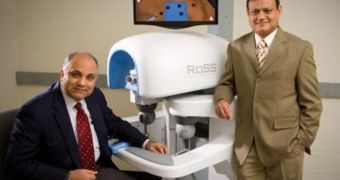With the advent of robotic surgery systems such as the da Vinci, the world of doctors performing these procedures has changed. The classical way of doing things, in which the surgeon is taught how to “feel” his or her way through an incision, is now being replaced by methods in which new practitioners are trained in the way of feeling through electronic arms. However, operating such robotic systems is an enormously complex task, and so the need for a simulator was mounting in the surgeon community. For precisely this reason, the RoSS system was developed.
The Robotic Surgical Simulator (RoSS) was constructed by scientists based at the Roswell Park Cancer Institute's Center for Robotic Surgery, who worked closely with colleagues from the University of Buffalo's (UB) School of Engineering and Applied Sciences. The new system approximates the touch and feel of the da Vinci robotic surgeon with remarkable precision, and so the tool could readily be employed in hospitals that already use this approach in conducting surgeries. Doing so would eliminate a lot of the trial-and-error procedures that surgeons currently have to perform, in order to form some experience in using these complex machines.
The da Vinci device “is only as good as the pilot, and the current training required for proficiency in robot-assisted surgery is unfortunately less than ideal. While surgical practice does make perfect, we believe that through better training tools, the early learning curve of robot-assisted surgery can be shortened without jeopardizing the safety and welfare of patients,” explains RPCI Department of Urology attending surgeon Khurshid A. Guru, MD. He is also the director of the Center for Robotic Surgery at the Institute. “Think of the RoSS as a flight simulator for surgeons,” adds UB professor of mechanical and aerospace engineering Thenkurussi Kesavadas.
He is the head of the Virtual Reality Lab at the university, and worked together with Guru on developing RoSS. The two also founded Simulated Surgical Systems, LLC, a spin-off based in Western New York, to provide them with a means of commercializing the new simulators. “The RoSS will have a major impact on improving surgical outcomes. The product's relevance will grow in direct proportion to the acceptance and application of robot-assisted surgery as a best practice around the world. The training that RoSS provides will eventually translate into better quality of life for thousands of patients,” concludes RPCI President and Chief Executive Officer, Donald L. Trump, MD.

 14 DAY TRIAL //
14 DAY TRIAL //